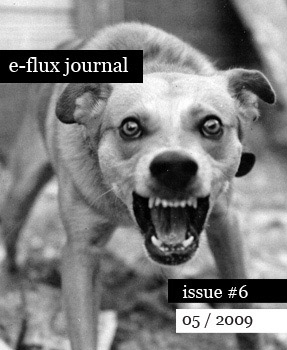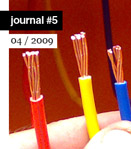
e-flux journal
issue #6:
EXCAVATING THE FUTURE
May 2009
Available online:
http://e-flux.com/journal
Projections of the future that were made in the past are often striking in their bold na´vete—didn't people understand then that future projections always end up looking like caricatures of past concerns? But whereas these projections do little to actually activate the future they foresaw, they do function as expressions of pure intention, and in this sense they are probably not so na´ve. Rather, they indicate a certain bold willingness on the part of people of a certain time to define in explicit terms exactly how the future should function, and indeed, most of these projected futures never come to pass—they remain possibilities that the present still fails to activate. So in this sense, we may not even be talking about the future at all here, or rather we are interested in the future as a stand-in for the "bold na´vete" of speaking about things as they should be.
We owe the theme of this issue to Dieter Roelstraete, whose last contribution on the recent "historiographic turn" in art concluded by lamenting the absence of future models available to a current moment marked by an "inability to grasp or even look at the present, much less to excavate the future." When Zdenka Badovinac offered to respond to the piece, we decided to invite a number of other contributors to write on the topic of "Excavating the Future." In response to Dieter's question, what we find is that perhaps the absence of future models is ascribable not to any hopeless lack of universal significance—an absence of ideology—but rather to the very immanence of the future as a kind of offsite space where certain possibilities can be explored momentarily before being drawn back into the reality of the present.
In the twentieth century, future projections were bound inextricably to those of modernity itself. When modernism took it upon itself to resolve historical inequities, it saw highly ideological forms of central planning as the means of realizing these resolutions, and in this, Marion von Osten finds a fundamental rupture in modernity's logic. Based on her extensive research on housing developments and urban planning methodologies applied in Europe and in its colonies in the era of decolonization and High Modernism, von Osten encounters a twofaced modernist discourse whose liberating claims were so embedded in the logic of central planning and control that it has become nearly impossible to consider the actual position of architecture's inhabitants—who invariably present other modernities altogether, as their own methods of building and living return modernism's planned worlds to the field of daily life.
If the future will indeed be jerry-rigged by its inhabitants, Gean Moreno and Ernesto Oroza already find it at work in immigrant neighborhoods such as Miami's Little Haiti, where improvised building practices form an architecture of necessity in which modernism's teleology is "replaced with radical pragmatics." When one approaches a stolen milk crate becoming a table for selling pirated DVDs as a crucial part of the urban landscape rather than an isolated instance, the urban landscape is transformed from a planned grid to a collection of raw materials and potentialities. To see promiscuous improvisation and hybridization as more emblematic of urban life than civic institutions and planning, one can begin to imagine how "entirely new cities emerge within the shells of buildings that speak to the concerns of another time."
"We are moving toward the end of the exploitation of nature, of work, of trade, of predation, of separation from the self, of sacrifice, of guilt, of the forsaking of happiness, of the fetishizing of money, of power, of hierarchy, of contempt for and fear of women, of the misleading of children, of intellectual dominion, of military and police despotism, of religions, of ideologies, of repression and the deadly resolutions of psychic tensions," claims Raoul Vaneigem in Hans Ulrich Obrist's conversation with the Belgian writer, philosopher, and former member of the Situationist International. Vaneigem reminds us of a moment when (or a place where) it seemed as if we brushed up against the future we wanted, or at least the conditions for imagining ideal scenarios for living. (see full essay here) And then there are also ideal scenarios for not dying. Michael Baers visits Bucharest for his latest installment, visiting Alexandra Croitoru and Stefan Tiron, who are part of a collective researching survival techniques for a "global cataclysm in the 2nd world context." In their own kind of architecture-in-waiting, Croitoru and Tiron approach the city of Bucharest as a collection of movable parts waiting to be repurposed—a typical Orthodox church, mall, or crypt are considered for their structural benefits for a post-apocalyptic population.
Mariana Silva and Pedro Neves Marques' "The Escape Route's Design" stages a dialogue between the incomplete projects in Ilya Kabakov's Palace of Projects and the series of attempts at crossing the Berlin Wall from East to West from the 60s until the mid 80s. Taking the shape of a case study that reads as an oblique comparison between artistic proposals and historical events, the text is an ambitious attempt at positioning a possibility for actual utopian projects to emerge from a space between the indeterminacy of the artistic proposal and the highly determined political action—a space that forms the escape route that Silva and Marques wish to identify. First presented in Berlin last June in the form of a bilingual Portuguese/English book edited and designed by the artists, the launch of the book was accompanied by a three-day presentation based loosely around concepts explored in the book, which concluded when the last booklet was given away.
Zdenka Badovinac looks at how Eastern European artists have used strategies of repetition and borrowing as a means of responding to the real. As Laibach and NSK, Brecht, or Walter Benjamin have shown, repetition could be deployed as a means of absorbing a logic of redundancy and enclosure in order to re-enunciate it on their own terms. As Badovinac states about the artist group Janez Janša, "They demonstrated that forms defined by repeatability are an essential condition of our life and work, and that what is increasingly important is the difference beyond difference: new forms of citizenship that transcend political and formal identity."
Finally, in Dieter Roelstraete's continuation of his essay "The Way of the Shovel: On the Archeological Imaginary in Art" from issue #4, he calls for a response to the melancholic fascination with history in the form of an assertive claim to the present. For Roelstraete, if art is to have any generative capacity worth mentioning, it must define a relationship to its present. And this definition can be quite literal, even taking the form of new isms and movements, with all their universalist claims. However these claims might overdetermine contemporary production, the willingness to frame the circumstances surrounding art more importantly signifies a willingness to engage the reality of the present, as well as the significance of its place in future histories.
- Julieta Aranda, Brian Kuan Wood, and Anton Vidokle


